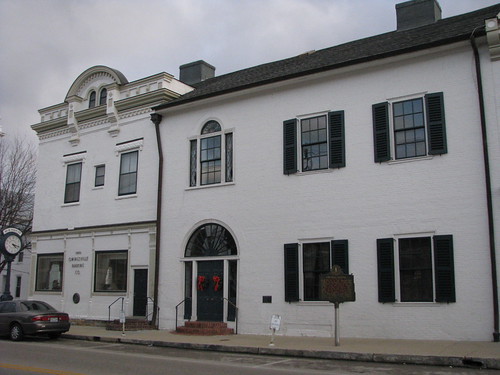 |
| The Owings House – Owingsville, Ky. |
The lore surrounding the Owings House in downtown Owingsville is epic.
In 1795, Colonel Thomas Dye Owings was sent from Maryland to Kentucky by his father to operate some of the first iron furnaces in the region. Within fifteen years, Owings had amassed a good deal of wealth and land. Along with Colonel Richard H. Menefee, Owings would found the community that took his name, Owingsville.
Owings and Menefee each owned significant parcels of land in what would become Owingsville. To select whose name the community would take, the two men wagered that the man who built the finer home the quickest would be the namesake of the town. For the sum of $60,000, Owings won the contest. (Menefee, a good politician and acclaimed orator – the “Patrick Henry of the West” – died a pauper, his greatest legacy being a Kentucky county which bears his misspelled name).
Although there is no concrete evidence, it is widely believed that the Maryland native retained Washington, D.C. architect Benjamin Latrobe to design the Owings House. Some features of the property remind the writer of Latrobe’s work, including the Palladian window over the front door and the spiral staircase inside. In fact, the staircase was constructed in Baltimore and was carried overland by oxen before it was assembled and installed. The staircase alone was $10,000! The Owings House was completed in 1814 and soon was one of the destinations for Kentucky’s political elite.
Another guest of the house, from July 17, 1814 through July 22, 1815, was the exiled Louis Philippe of France (King from 1830 – 1848). This, too, is disputed as some believe that the houseguest was an imposter posing as the young Frenchman. It is true, however, that Louis Philippe was in Kentucky decades earlier when he lodged at Bardstown’s Talbott Tavern.
During the War of 1812, Owings raised a Kentucky regiment and was commissioned a colonel in the 28th U.S. Infantry. He also served in politics, as sheriff and as a judge. Ultimately, Owings’ business success faltered and he declared bankruptcy before leaving for Texas where he would serve first for Stephen Austin in Texas’ War of Independence before serving the U.S. in the Mexican War. Colonel Owings died and is buried in Texas.
In 1905, the east third of the Owings House was modified and adapted for use as a bank, the Owingsville Banking Company, which remains in operation today. All five bays pictured were part of Owings’ original home which bested Menefee in competition.
Bibliography
Bath County Tourism
National Register of Historic Places.
“Thomas Dye Owings” by W. T. Block
